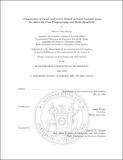Computation of upper and lower bounds in limit analysis using second-order cone programming and mesh adaptivity
Author(s)
Ciria Suárez, Héctor, 1979-
DownloadFull printable version (4.215Mb)
Other Contributors
Massachusetts Institute of Technology. Dept. of Aeronautics and Astronautics.
Advisor
Jamie Peraire.
Terms of use
Metadata
Show full item recordAbstract
Limit analysis is relevant in many practical engineering areas such as the design of mechanical structures or the analysis of soil mechanics. Assuming a rigid, perfectly-plastic solid subject to a static load distribution, the problem of limit analysis consists of finding the minimum multiple of this load distribution that will cause the body to collapse. This collapse multiplier results from solving an infinite dimensional saddle point problem, where the internal work rate is maximized over an admissible set of stresses -defined by a yield condition- and minimized over the linear space of kinematically admissible velocities for which the external work rate equals the unity. When strong duality is applied to this saddle point problem, the well-known convex (and equivalent) static and kinematic principles of limit analysis arise. In this thesis, an efficient procedure to compute strict upper and lower bounds for the exact collapse multiplier is presented, with a formulation that explicitly considers the exact convex yield condition. The approach consists of two main steps. First, the continuous problem, under the form of the static principle, is discretized twice (one per bound) by means of different combinations of finite element spaces for the stresses and velocities. For each discretization, the interpolation spaces are chosen so that the attainment of an upper or a lower bound is guaranteed. The second step consists of solving the resulting discrete nonlinear optimization problems. Towards this end, they are reformulated into the canonical form of Second-order Cone Programs, which allows for the use of primal-dual interior point methods that optimally exploit the convexity and duality properties of the limit analysis (cont.) model and guarantee global convergence to the optimal solutions. To exploit the fact that collapse mechanisms are typically highly localized, a novel method for adaptive meshing is introduced based on local bound gap measures and not on heuristic estimates. The method decomposes the total bound gap as the sum of positive elemental contributions from each element in the mesh, and refines only those elements which are responsible for the majority of the numerical error. Finally, stand-alone computational certificates that allow the bounds to be verified independently, without recourse to the original computer program, are also provided. This removes the uncertainty about the reliability of the results, which frequently undermines the utility of computational simulations. The efficiency of the methodology proposed is illustrated with several applications in plane stress and plane strain, demonstrating that it can be used in complex, realistic problems as a supplement to other models.
Description
Thesis (S.M.)--Massachusetts Institute of Technology, Dept. of Aeronautics and Astronautics, 2004. Includes bibliographical references (p. 109-111). This electronic version was submitted by the student author. The certified thesis is available in the Institute Archives and Special Collections.
Date issued
2004Department
Massachusetts Institute of Technology. Department of Aeronautics and AstronauticsPublisher
Massachusetts Institute of Technology
Keywords
Aeronautics and Astronautics.